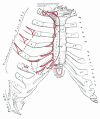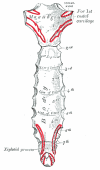Xiphodynia: a diagnostic conundrum - PubMed (original) (raw)
Xiphodynia: a diagnostic conundrum
J Keith Simpson et al. Chiropr Osteopat. 2007.
Abstract
This paper presents 3 case reports of xiphodynia that presented to a chiropractic clinic. The paper examines aspects of xiphodynia including relevant anatomy of the xiphoid, as well as the incidence, aetiology, symptoms, diagnosis, and treatment. A brief overview of the mechanism of referred pain is presented.
Figures
Figure 1
The sternum – anterior surface [8]. Figure 1 shows the anterior surface of sternum and costal cartilages. Muscular attachments are shown in red.
Figure 2
The sternum – posterior surface [8]. Figure 2 shows the posterior surface of the sternum. Muscular attachments are shown in red.
Similar articles
- Xiphoidectomy for Intractable Xiphodynia.
Dorn P, Kuhn MA, Schweizer BA, Schmid RA, Kocher GJ. Dorn P, et al. World J Surg. 2018 Nov;42(11):3646-3650. doi: 10.1007/s00268-018-4668-9. World J Surg. 2018. PMID: 29770873 - Operative results after xiphoidectomy in patients with xiphodynia.
Garssen FP, Aalders MB, van der Poel MJ, Zuidema WP. Garssen FP, et al. Asian Cardiovasc Thorac Ann. 2021 Oct;29(8):779-783. doi: 10.1177/02184923211019179. Epub 2021 May 20. Asian Cardiovasc Thorac Ann. 2021. PMID: 34011167 Free PMC article. - Treatment and Management of Xiphoidalgia.
Noor N, Amgalan A, Vij N, Habib K, Anantuni L, An D, Kassem H, Paladini A, Varrassi G, Kaye AD. Noor N, et al. Orthop Rev (Pavia). 2022 Aug 25;14(3):37070. doi: 10.52965/001c.37070. eCollection 2022. Orthop Rev (Pavia). 2022. PMID: 36034722 Free PMC article. Review. - Xiphodynia as an Unusual Cause of Chest Pain: A Case Series.
van Boekel A, Stollenwerck G, Ritchie ED, Vogels S. van Boekel A, et al. Surg J (N Y). 2023 Feb 7;9(1):e39-e43. doi: 10.1055/s-0043-1761270. eCollection 2023 Jan. Surg J (N Y). 2023. PMID: 36762001 Free PMC article. - Chiropractic treatment of upper extremity conditions: a systematic review.
McHardy A, Hoskins W, Pollard H, Onley R, Windsham R. McHardy A, et al. J Manipulative Physiol Ther. 2008 Feb;31(2):146-59. doi: 10.1016/j.jmpt.2007.12.004. J Manipulative Physiol Ther. 2008. PMID: 18328941 Review.
Cited by
- Morphology of the human xiphoid process: dissection and radiography of cadavers and MDCT of patients.
Xie YZ, Wang BJ, Yun JS, Chung GH, Ma ZB, Li XJ, Kim IS, Chai OH, Han EH, Kim HT, Song CH. Xie YZ, et al. Surg Radiol Anat. 2014 Apr;36(3):209-17. doi: 10.1007/s00276-013-1163-8. Epub 2013 Jul 10. Surg Radiol Anat. 2014. PMID: 23839070 - A case series: xiphoidectomy for xiphodynia, a rare thoracic wall disorder.
Bakens MJAM, Andel PCM, Daemen JHT, Hulsewé KWE, Vissers YLJ, de Loos ER. Bakens MJAM, et al. J Thorac Dis. 2021 Apr;13(4):2216-2223. doi: 10.21037/jtd-20-3396. J Thorac Dis. 2021. PMID: 34012572 Free PMC article. - Xiphodynia Caused by a Large Xiphoid Process.
Tsuchida T, Ishizuka K, Ohira Y. Tsuchida T, et al. Cureus. 2023 Sep 1;15(9):e44516. doi: 10.7759/cureus.44516. eCollection 2023 Sep. Cureus. 2023. PMID: 37790055 Free PMC article. - Xiphoidectomy: A Surgical Intervention for an Underdocumented Disorder.
Hogerzeil DP, Hartholt KA, de Vries MR. Hogerzeil DP, et al. Case Rep Surg. 2016;2016:9306262. doi: 10.1155/2016/9306262. Epub 2016 Nov 9. Case Rep Surg. 2016. PMID: 27900228 Free PMC article. - Xiphodynia with limited decrease in the xiphoid process-sternal angle but recognised compression of the rectus abdominis.
Ono R, Horibata K. Ono R, et al. BMJ Case Rep. 2024 Feb 7;17(2):e259176. doi: 10.1136/bcr-2023-259176. BMJ Case Rep. 2024. PMID: 38331450
References
- Sklaroff H. Xiphodynia – Another Cause of Atypical Chest Pain: Six Case Reports. Mt Sinai J Med. 1979;46:546–548. - PubMed
LinkOut - more resources
Full Text Sources

